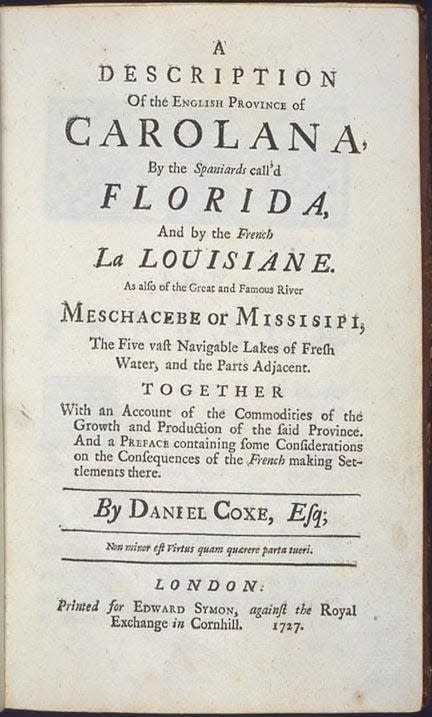Visiting Our Past: Real estate development schemes in WNC date back as far as 1722

Speculators have been trying to lure settlers to the Eden of Carolina ever since Daniel Coxe IV published "A Description of the English Province of Carolana (sic)" in 1722. Coxe took up the torch of his father, who, 30 years earlier, had "purchased the patent of province" of "Carolana" — an Atlantic-to-Pacific deal — after he'd relinquished a million acres in New Jersey.
In his "Description," Daniel IV proposed forming a United States — the first known proposal of this nature — apparently for the purpose of commerce.
Daniel IV's grandson, Tench Coxe, a delegate to the Continental Congress and later assistant secretary of the treasury, famously proposed the industrialization of the South. In the 1790s, Tench added hundreds of thousands of Western North Carolina acres to his portfolio.
Tench's grandson, Col. Frank Coxe, continued the family's interest in the region. He helped finance the Western North Carolina Railroad and bought Joseph McDowell Carson's mansion on the Green River in Polk County.
We skip two more generations. Coxe heirs couldn't keep up their property, and it ended up, after a few exchanges, in the hands of Dennis Palenscar. For a brief, ill-financed period in 1986-87, Palenscar attempted to create "Fantasy Island for Southerners."
Palenscar's executive assistant, Claudia Hamrick, said in an article written by Tony Earley for the Forest City Daily Courier, "If you questioned anything in a sales meeting, particularly the credibility of him (Palenscar) or the project, he would get extremely defensive. He always told us that if we didn't make the sale, it was a problem with our credibility."
Paradise-seekers had purchased 58 lifetime memberships and RV park spots by December 1986, but the company's checks started bouncing. Hamrick said that Palenscar "often asked her to tell creditors that he was in Toledo visiting his sick mother when he was in the next room." She said she "heard Palenscar tell a creditor that he was having trouble paying bills because his employees had stolen cash and checks from him."
This is the story of a dream gone bad. It is a part of the story of high-end development in Western North Carolina, which deserves its own literature. The writer of the Forest City article, as it turns out, is the Tony Earley, who has gone on to become one of our country's most celebrated novelists, author of "Jim the Boy" and "The Blue Star."
Shortly after Palenscar's fiasco, Ellen and Eugene Cantrell purchased the Green River Plantation, authentically restored it and established a viable business of historic tours, bed-and-breakfast lodging and special event hosting. The Green River Plantation is the jewel in the crown in a rural county that is suddenly becoming jewel-studded.
Stories as romantic, tragic and epic as the ones surrounding the Coxes reside in every mountain development. Another one of the most famous examples — as judged by its place in literature — is the development of Beaverdam Road, the home of the late, great author, Wilma Dykeman, in North Asheville.
In her preface to the 1974 edition of her classic chronicle "The French Broad," Dykeman wrote, "Companies catering to the recreational and resort and leisure demands of a restless urban public ... are accumulating significant mountain empires and 'developing' them at a breathtaking rate. ... It seems to become increasingly evident that development of a basic philosophy for resource use ... is long overdue."
Dykeman also put her development stories into memorable fiction: Lydia McQueen restoring the spring at her home place in "The Tall Woman," and Clay Thurston, the construction worker protagonist of "The Far Family," driving his car off the ledge of a curvy mountain road like the ones that descend from the Blue Ridge Parkway at Elk Mountain.

Rob Neufeld wrote the local history feature "Visiting Our Past" for the Citizen Times until his death in 2019. This column originally was published May 14, 2008.
This article originally appeared on Asheville Citizen Times: Real estate schemes in Western North Carolina date back as far as 1722

